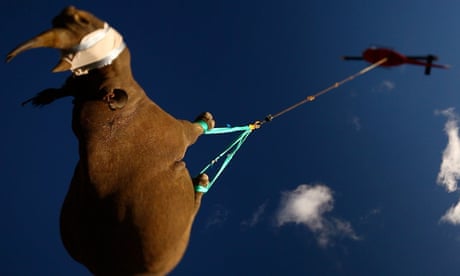Electric chopsticks and ‘jamais vu’ studies also scoop awards recognising research that makes people ‘laugh, then think’
Nicola Davis
The winner of the Ig Nobel prize for public health, Seung-min Park, in front of Rodin’s thinker statue at Stanford University. Photograph: PR Image/Natuurhistorisch Museum Rotterdam
From using dead spiders to grip objects to probing the weird feeling that occurs when the same word is written over and over again, researchers investigating some of the quirkiest conundrums in science have been honoured in this year’s Ig Nobel prizes.
Unlike the rather more stately Nobel prizes – which will be announced next month – the Ig Nobel prizes celebrate unusual areas of research that “make people laugh, then think”. They also come with a rather less majestic cheque: this year’s winning teams will each receive a 10 trillion dollar bill … from Zimbabwe.
Produced by the magazine Annals of Improbable Research, Thursday’s online ceremony featured real Nobel laureates awarding 10 Ig Nobel prizes to researchers around the world, with the award taking the form of a pdf document that could be printed and assembled to create a three-dimensional trophy.

Upside down rhinos and nose-clearing orgasm studies win Ig Nobel prize
Taking the Ig Nobel mechanical engineering prize for their work on reanimating dead spiders for use as mechanical gripping tools was a team that included Te Faye Yap and Daniel Preston from Rice University in the US.
“While setting up our lab, we noticed a dead, curled-up spider at the edge of a hallway,” said Yap. “Our ‘aha!’ moment occurred when we found that spiders only have flexor muscles to contract their legs inward and rely on hydraulic pressure to extend their legs outward.”
In other words, a dead spider’s legs naturally sit in a “closed” state like a clenched fist, but the legs can be extended, and the grip opened, by applying pressure.
Using this “necrobotic” approach, the team created a spider-based gripper that could, among other features, grasp objects with irregular shapes.
“Furthermore, the gripper can serve as a handheld device and innately camouflages in outdoor environments,” the researchers wrote in the study.
Speaking before the ceremony, Preston said: “We follow every year’s Ig Nobel prizes to see the creative and thought-provoking work they highlight, and several of our science role models have won in the past, so we were incredibly excited to receive this honour and join their ranks.”
Unlike the rather more stately Nobel prizes – which will be announced next month – the Ig Nobel prizes celebrate unusual areas of research that “make people laugh, then think”. They also come with a rather less majestic cheque: this year’s winning teams will each receive a 10 trillion dollar bill … from Zimbabwe.
Produced by the magazine Annals of Improbable Research, Thursday’s online ceremony featured real Nobel laureates awarding 10 Ig Nobel prizes to researchers around the world, with the award taking the form of a pdf document that could be printed and assembled to create a three-dimensional trophy.

Upside down rhinos and nose-clearing orgasm studies win Ig Nobel prize
Taking the Ig Nobel mechanical engineering prize for their work on reanimating dead spiders for use as mechanical gripping tools was a team that included Te Faye Yap and Daniel Preston from Rice University in the US.
“While setting up our lab, we noticed a dead, curled-up spider at the edge of a hallway,” said Yap. “Our ‘aha!’ moment occurred when we found that spiders only have flexor muscles to contract their legs inward and rely on hydraulic pressure to extend their legs outward.”
In other words, a dead spider’s legs naturally sit in a “closed” state like a clenched fist, but the legs can be extended, and the grip opened, by applying pressure.
Using this “necrobotic” approach, the team created a spider-based gripper that could, among other features, grasp objects with irregular shapes.
“Furthermore, the gripper can serve as a handheld device and innately camouflages in outdoor environments,” the researchers wrote in the study.
Speaking before the ceremony, Preston said: “We follow every year’s Ig Nobel prizes to see the creative and thought-provoking work they highlight, and several of our science role models have won in the past, so we were incredibly excited to receive this honour and join their ranks.”

The team behind the spider gripping tool:
from left, Daniel Preston, Anoop Rajappan, Zhen Liu, Trevor Shimokusu and Te Faye Yap.
Photograph: Natuurhistorisch Museum Rotterdam
As well as the awards, the 2023 event included the premiere of seven songs on the topic of water, plus eminent researchers explaining their subjects in just 24 seconds, and then in only seven words.
Among other prize winners was Jan Zalasiewicz of the University of Leicester, who won the Ig Nobel prize for chemistry and geology for explaining why many scientists like to lick rocks. He revealed that while the 18th-century Italian geologist Giovanni Arduino used taste to help identify rocks and minerals, modern field geologists often apply their tongue for a different reason.
“We do it to help the sense of sight, not taste, because a wet surface shows up the mineral particles better than a dry one does,” said Zalasiewicz.
Perhaps more appetising is the Ig Nobel prize for nutrition, won this year by Homei Miyashita from Meiji University and Hiromi Nakamura of the University of Tokyo for their research on electrified chopsticks and drinking straws.
“The taste of food can be changed immediately and reversibly by electrical stimulation, and this is something that has been difficult to achieve with conventional ingredients such as seasonings,” said Nakamura. She said her recent research had shown it was possible to enhance the saltiness of foods using electrical stimulation of the tongue.
Focusing on the other end of the digestive system, this year’s Ig Nobel prize for public health was awarded to researchers for the development of a smart toilet that uses various technologies to monitor human waste for signs of disease and an anal-print sensor as part of its system to identify the user.
The award for medicine went to researchers who used cadavers to explore whether each of an individual’s nostrils contains an equal number of hairs, while the communication prize was scooped by scientists who have conducted investigations, including neuroimaging analyses, into people who are expert at speaking backwards.
Elsewhere, the literature prize went to researchers exploring the peculiar feeling that can arise when the same word is repeatedly written – a phenomenon they say is an example of “jamais vu”, whereby people find the familiar to be unfamiliar – while the prize for physics went to researchers who discovered that the sexual activity of anchovies, which gather at night off the Galician coast to spawn, can create small whirls that mix different layers of water in the oceans.
As well as the awards, the 2023 event included the premiere of seven songs on the topic of water, plus eminent researchers explaining their subjects in just 24 seconds, and then in only seven words.
Among other prize winners was Jan Zalasiewicz of the University of Leicester, who won the Ig Nobel prize for chemistry and geology for explaining why many scientists like to lick rocks. He revealed that while the 18th-century Italian geologist Giovanni Arduino used taste to help identify rocks and minerals, modern field geologists often apply their tongue for a different reason.
“We do it to help the sense of sight, not taste, because a wet surface shows up the mineral particles better than a dry one does,” said Zalasiewicz.
Perhaps more appetising is the Ig Nobel prize for nutrition, won this year by Homei Miyashita from Meiji University and Hiromi Nakamura of the University of Tokyo for their research on electrified chopsticks and drinking straws.
“The taste of food can be changed immediately and reversibly by electrical stimulation, and this is something that has been difficult to achieve with conventional ingredients such as seasonings,” said Nakamura. She said her recent research had shown it was possible to enhance the saltiness of foods using electrical stimulation of the tongue.
Focusing on the other end of the digestive system, this year’s Ig Nobel prize for public health was awarded to researchers for the development of a smart toilet that uses various technologies to monitor human waste for signs of disease and an anal-print sensor as part of its system to identify the user.
The award for medicine went to researchers who used cadavers to explore whether each of an individual’s nostrils contains an equal number of hairs, while the communication prize was scooped by scientists who have conducted investigations, including neuroimaging analyses, into people who are expert at speaking backwards.
Elsewhere, the literature prize went to researchers exploring the peculiar feeling that can arise when the same word is repeatedly written – a phenomenon they say is an example of “jamais vu”, whereby people find the familiar to be unfamiliar – while the prize for physics went to researchers who discovered that the sexual activity of anchovies, which gather at night off the Galician coast to spawn, can create small whirls that mix different layers of water in the oceans.

A school of anchovies potentially performing ‘small-scale physics’.
Photograph: Sirachai Arunrugstichai/Getty Images
Bieito Fernández Castro, of the University of Southampton, one of the winning team, said that while surprised by the award, he welcomed the Ig Nobel prize.
“I have never thought that a piece of research about the small-scale physics of the ocean could have attracted such broad attention,” he said.
This article was amended on 15 September 2023. An early version stated Jan Zalasiewicz is from the University of Southampton. This has been corrected
Bieito Fernández Castro, of the University of Southampton, one of the winning team, said that while surprised by the award, he welcomed the Ig Nobel prize.
“I have never thought that a piece of research about the small-scale physics of the ocean could have attracted such broad attention,” he said.
This article was amended on 15 September 2023. An early version stated Jan Zalasiewicz is from the University of Southampton. This has been corrected

No comments:
Post a Comment